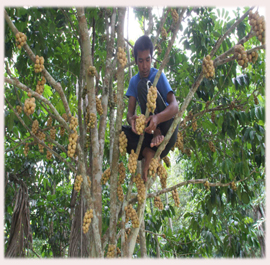The plight of longgong orchard owners
 The brutal killing of five people by suspected militants at a fruit market in Sai Buri district of Pattani on September 29 has caused a big scare among “longgong” (scientifically named as Lansium domesticum Corr.) traders and the growers of this famous tropical fruit of southern Thailand.
The brutal killing of five people by suspected militants at a fruit market in Sai Buri district of Pattani on September 29 has caused a big scare among “longgong” (scientifically named as Lansium domesticum Corr.) traders and the growers of this famous tropical fruit of southern Thailand.
The incident also threatened to further dampen the prices of longgong which was already declining steadily even before the shooting.
Mrs Anong Poklom, 35, a longgong trader from Nakhon Si Thammarat was at the fruit market in Sai Buri district with her two employees, Sririchai Viset, a native of Si Sa Ket and Puvanart Muangmaithong, a native of Surin province. As Mrs Anong was negotiating the prices of longgong with the two sellers, Mapairu, 18, and Masalan Yusho, 23, gunmen believed to be militants who appeared to have laid in waiting at the market approached the group and opened fire with M16 assault rifles and automatic pistols.
Mrs Anong and her two employees as well as Mapairu and Masalan were killed instantly at the scene. Three other people were also injured. A total of 28 bullet casings were found at the crime scene.
Pol Colonel Amnart Dee, superintendent of Sai Buri district police, blamed the murders on a militant gang led by Manang Bueraheng and Yagariya Pawo. He said the shooting was intended to strike fear among the people and to avenge for the recent killings of their fellow militants by security forces.
A longgong merchant in Yala province, Koriyoh Salaeahnt, admitted that the September 29 incident had scared him from venturing into a longgong orchard to pick the fruit. He said he had already paid for the price of the fruit covering four rai and expected that all his investment would be lost.
Suemang Mudo, a 24-year villager of Kok Po district of Pattani who made a living by picking longgong, said he had called his boss whether he should go ahead with picking the fruit but was told to take a break for fear of his safety and also because of the low prices. “My boss said that the price of the fruit now was between 4-5 baht a kilo which was not worth of picking,” said Suemang, adding that he had to shift to collecting dried rubber saplings just to make a living.
“My boss said that the price of the fruit now was between 4-5 baht a kilo which was not worth of picking,” said Suemang, adding that he had to shift to collecting dried rubber saplings just to make a living.
The price of longgong which averaged about 10 baht a kilo last year now fetched between 4-5 baht a kilo with the top grade of Tanyongmas longgong being priced at 20 plus baht a kilo while the cost averaged 11.50 baht a kilo.
Longgong was mostly grown in the three southernmost provinces. According to the Zone 8 agricultural research and development centre, there were 331,117 rai grown with longgong last year which was 1.4 percent down from a year ago. Of these, 80,143 rai are in Narathiwat, 51,416 rai in Yala, 36,329 rai in Chumporn, 35,062 rai in Nakhon Si Thammarat and 24,742 rai in Songkhla.
Last year along, total production of longgong was registered at 137,217 tonnes with Narathiwat being the biggest producer with 22,957 tonnes.
After the deadly incident, Pattani governor Thirathep Sriyaphan has ordered security to be stepped up to protect longgong buyers especially those outside the three southernmost provinces. He admitted that the incident had scared away many buyers.
To help longgong growers, the government has been arranging the fruit to be transported in a caravan of trucks from Yala and Narathiwat to be sold to consumers in Bangkok.
----------------------------------------------------------------------------------------
Photos by Abdullah Wangni
Captions : Suemang Mudo, a 24-year villager of Kok Po district of Pattani who made a living by picking longgong
